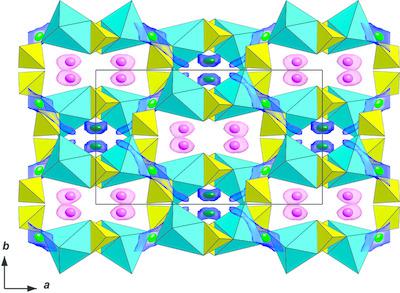当前位置:
X-MOL 学术
›
J. Appl. Crystallogr.
›
论文详情
Our official English website, www.x-mol.net, welcomes your
feedback! (Note: you will need to create a separate account there.)
Expanding the family of mineral‐like anhydrous alkali copper sulfate framework structures: new phases, topological analysis and evaluation of ion migration potentialities
Journal of Applied Crystallography ( IF 5.2 ) Pub Date : 2021-01-27 , DOI: 10.1107/s1600576720015824 Artem S. Borisov , Oleg I. Siidra , Vadim M. Kovrugin , Andrey A. Golov , Wulf Depmeier , Evgeny V. Nazarchuk , Astrid Holzheid
Journal of Applied Crystallography ( IF 5.2 ) Pub Date : 2021-01-27 , DOI: 10.1107/s1600576720015824 Artem S. Borisov , Oleg I. Siidra , Vadim M. Kovrugin , Andrey A. Golov , Wulf Depmeier , Evgeny V. Nazarchuk , Astrid Holzheid

|
Two novel compounds, K2Cu3(SO4)4 and KNaCu(SO4)2, were synthesized. The crystal structure of K2Cu3(SO4)4 is based on a [Cu3(SO4)4]2− framework with relatively simple bond topology, but with four different CuOn polyhedron geometries. The K+ cations reside in the pores of the framework. The [Cu(SO4)2]2− framework in KNaCu(SO4)2 encloses large elliptical channels running along [001]. Larger channels are occupied by K+, whereas smaller ones are filled by Na+. The bond‐valence energy landscape (BVEL) approach has been demonstrated to be a useful method for the prediction of the mobility of alkali metal ions in various structures. By means of this approach, the threshold energies at which isosurfaces begin to percolate as well as the directions of possible ion migration in the structures were determined. The modelling of ion migration maps by the analysis of the procrystal electron‐density distribution was used to rapidly identify ion migration pathways and limiting barriers between particular crystallographic sites in the structures under consideration. Its consistency and complementarity with the BVEL method have been demonstrated. Both approaches revealed a relatively low ion threshold percolation and migration barriers in the cryptochalcite‐type structures [cryptochalcite: K2Cu5O(SO4)5]. Hence, one may assume that its 3D framework type is suited for ion transport applications. The review of all known members of the groups of anhydrous copper sulfates did not reveal a correlation between the porosity of the framework structures and a manifestation of ion conduction properties.
中文翻译:

扩大类矿物无水碱式硫酸铜骨架结构的家族:新相,拓扑分析和离子迁移潜力的评估
合成了两种新型化合物K 2 Cu 3(SO 4)4和KNaCu(SO 4)2。K 2 Cu 3(SO 4)4的晶体结构基于[Cu 3(SO 4)4 ] 2-骨架,具有相对简单的键合拓扑,但具有四个不同的CuO n多面体几何形状。K +阳离子位于骨架的孔中。KNaCu(SO 4)中的[Cu(SO 4)2 ] 2−骨架图2包围了沿[001]延伸的大椭圆通道。较大的通道被K +占据,而较小的通道被Na +占据。。价键能态图(BVEL)方法已被证明是一种预测各种结构中碱金属离子迁移率的有用方法。通过这种方法,确定了等值面开始渗透的阈值能量以及结构中可能的离子迁移的方向。通过分析前晶体电子密度分布对离子迁移图进行建模,可以快速确定所考虑结构中特定晶体学位点之间的离子迁移途径和限制壁垒。已经证明了其与BVEL方法的一致性和互补性。两种方法都显示出隐辉石型结构中的离子阈值渗滤和迁移障碍相对较低[隐钙铝石:K2 Cu 5 O(SO 4)5 ]。因此,可以假设其3D框架类型适用于离子传输应用。对无水硫酸铜基团的所有已知成员的综述均未揭示框架结构的孔隙率与离子传导性质的表现之间的相关性。
更新日期:2021-02-02
中文翻译:

扩大类矿物无水碱式硫酸铜骨架结构的家族:新相,拓扑分析和离子迁移潜力的评估
合成了两种新型化合物K 2 Cu 3(SO 4)4和KNaCu(SO 4)2。K 2 Cu 3(SO 4)4的晶体结构基于[Cu 3(SO 4)4 ] 2-骨架,具有相对简单的键合拓扑,但具有四个不同的CuO n多面体几何形状。K +阳离子位于骨架的孔中。KNaCu(SO 4)中的[Cu(SO 4)2 ] 2−骨架图2包围了沿[001]延伸的大椭圆通道。较大的通道被K +占据,而较小的通道被Na +占据。。价键能态图(BVEL)方法已被证明是一种预测各种结构中碱金属离子迁移率的有用方法。通过这种方法,确定了等值面开始渗透的阈值能量以及结构中可能的离子迁移的方向。通过分析前晶体电子密度分布对离子迁移图进行建模,可以快速确定所考虑结构中特定晶体学位点之间的离子迁移途径和限制壁垒。已经证明了其与BVEL方法的一致性和互补性。两种方法都显示出隐辉石型结构中的离子阈值渗滤和迁移障碍相对较低[隐钙铝石:K2 Cu 5 O(SO 4)5 ]。因此,可以假设其3D框架类型适用于离子传输应用。对无水硫酸铜基团的所有已知成员的综述均未揭示框架结构的孔隙率与离子传导性质的表现之间的相关性。











































 京公网安备 11010802027423号
京公网安备 11010802027423号